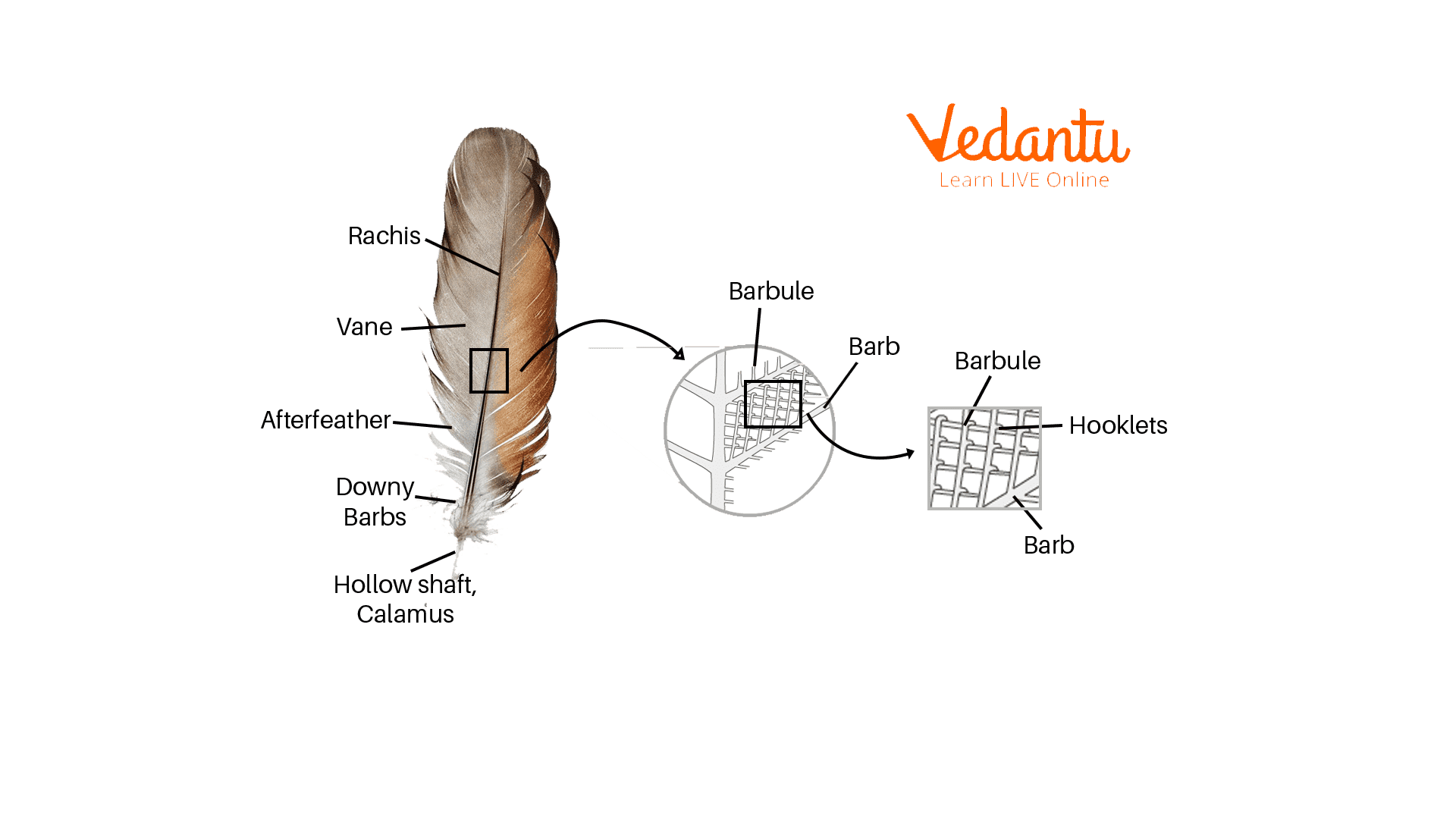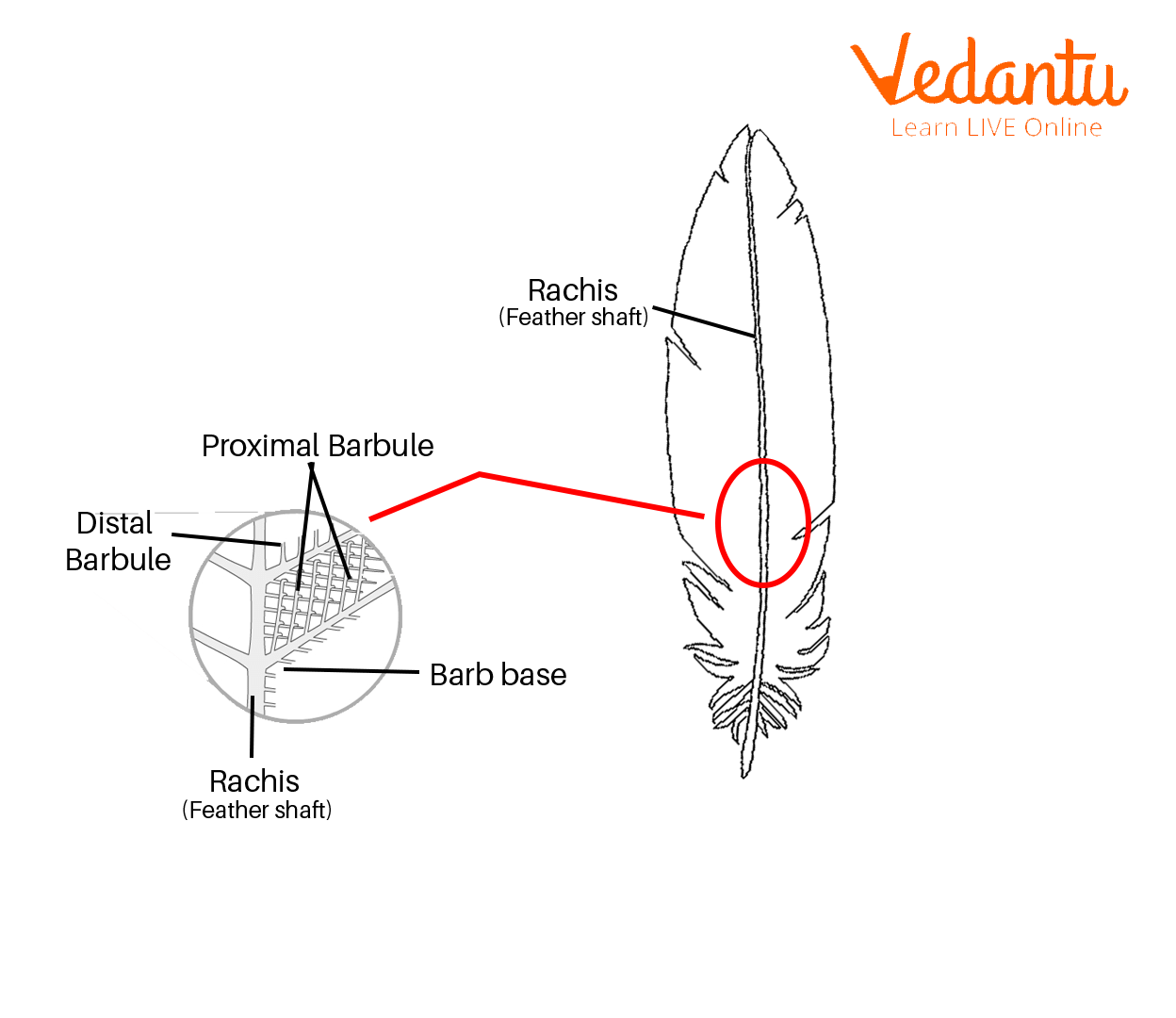Structure and Functions of a Feather with Diagram Explained
Feathers are remarkable biological structures unique to birds, crucial for flight, insulation, and display. Understanding the feather, its types, anatomy, and importance is essential for exploring avian biology and adaptation. Let’s delve into the features, structure, functions, and various examples that showcase the diversity and relevance of feathers in nature and science.
What is a Feather? - Feather Definition
Feather definition: A feather is a complex, lightweight epidermal outgrowth forming the main external covering of birds. Each feather is made of specialized proteins and serves multiple roles: enabling flight, regulating body temperature, camouflaging, and aiding in courtship. Feathers are one of the key features distinguishing the class Aves from other vertebrates.
Structure and Parts of a Feather
A typical feather has several key parts. Below is a well-labelled diagram and explanation to make feather anatomy clear for Class 12 and competitive exams. Understanding this structure helps students appreciate adaptations seen in different bird species.

- Shaft (Rachis): The central stiff stem supporting the feather.
- Quill (Calamus): Hollow base inserted into the bird’s skin.
- Vane: The flat, extended part on each side of the shaft, made up of barbs.
- Barbs: Parallel filaments branching from the rachis.
- Barbules: Tiny branches from each barb, with hooks called barbicels to interlock adjoining barbs.
These interlocking structures give the feather strength and flexibility, key for functions like flight and insulation.
Types and Examples of Feathers in Birds
Feathers can be classified into different types based on location and function. Each type supports important activities in birds’ lives and adaptations to different environments. Some major types include:
- Contour Feathers: Give birds their shape and color, covering outer body and wings.
- Flight Feathers: Large, strong feathers on wings (remiges) and tail (rectrices) enabling flight.
- Down Feathers: Soft and fluffy, found under contour feathers providing insulation, especially in young birds.
- Semi-plume Feathers: Intermediate in structure, assist with both shape and insulation.
- Filoplume Feathers: Hair-like, help in sensory feedback for controlling other feathers.
- Bristle Feathers: Stiff, hairlike feathers usually around mouth, nostrils, or eyes, serving a protective function.

Functions and Importance of Feathers
Feathers perform many vital functions not only for survival but also for the ecological balance. Their varied roles include:
- Flight: Flight feathers on wings and tail provide surface area and shape for lift and maneuvering.
- Insulation: Down and semi-plume feathers trap air for thermal regulation, helping birds survive temperature extremes.
- Communication and Mating: Brightly colored and patterned feathers are used for attracting mates and signaling.
- Camouflage: Some feathers blend birds into their environment, protecting them from predators.
- Protection: Feathers shield the skin from sun, wind, and rain.
Feathers also help in waterproofing due to special oils. They are crucial adaptations explaining the evolutionary success of birds. You can learn more about animal adaptations in our article on animal adaptations.
Feather Diagram (Labeled)
A well-labelled feather diagram is essential for biology exams, project work, and presentations. The diagram below highlights main parts important for Class 12, NEET, and Board exams:
- Quill (Calamus): Lower hollow tube anchoring the feather.
- Rachis: Main continuation of the shaft.
- Barbs and Barbules: Interlocking branches for strength and flexibility.
- Vane: Creates the surface essential for flight and coverage.
Studying the structure of a feather helps explain how birds can fly and adapt to different environments. For similar labelled diagrams, see our class 7 important diagrams resource.
How Do Feathers Develop and Grow?
Feathers grow from follicles in the bird’s skin, much like human hair. The development process is as follows:
- Initiation: A small bump (papilla) forms in the skin.
- Growth: Cells multiply, pushing outward and forming a tubular structure.
- Specialization: As the feather develops, cells differentiate to become barbs, barbules, and shaft.
- Maturation: The dead cells harden through keratinization, a process similar to human nails and hair formation.
- Eruption: The sheath enclosing the new feather breaks open, allowing the feather to unfurl.
Feathers are periodically replaced through a process called molting. This keeps birds’ plumage healthy, functional, and suited for seasonal changes. Feather growth and molting can be influenced by environmental factors—read more in effects of climate changes.
Feather Examples in Nature
There are several fascinating feather examples across different bird groups, each adapted for their specific needs:
- Peacock: Ornamental tail feathers used for courtship displays.
- Penguin: Specialized waterproof contour and down feathers for insulation in cold waters.
- Owl: Fringe-edged flight feathers for silent hunting.
- Duck: Waterproof feathers coated with oil.
- Woodpecker: Tail feathers support vertical climbing on trees.
From air travel to heat insulation, each feather example demonstrates fantastic evolutionary solutions tailored to bird lifestyles.
Feathers in Human Life and Research
Feathers have long been valuable to humans. They are used in bedding (down), writing (quills), clothing, cultural symbols, and even in scientific research. Analysis of fossil feathers informs scientists about dinosaur evolution, connecting birds to ancient reptiles. Feathers are also studied in environmental science to monitor pollution (since chemicals accumulate in feathers).
Understanding feathers also helps inform climate adaptation strategies. To explore animal and plant responses to climate, check out our section on effects of climate changes.
Feather Class 12 Key Points
- Feather is unique to birds (Aves).
- Structure: Quill, rachis, barbs, barbules, vane.
- Types: Contour, flight, down, semi-plume, filoplume, bristle.
- Functions: Flight, insulation, waterproofing, camouflage, courtship and communication.
- Importance in research, agriculture, and traditional uses.
- Relevant for MCQs and diagram-based questions in CBSE and NEET.
For more about traits and inherited characteristics, explore acquired and inherited traits. To learn about organs associated with movement, read muscular tissue.
Feather Questions and MCQs
Common feather MCQs and questions for exams often test on definition, structure, types, and function. Practice regularly for scoring high in biology.
- Q1. What are the main functions of feathers?
- Q2. Name and describe two types of feathers.
- Q3. How does the feather structure help in flight?
- Q4. Draw and label a feather diagram.
- Q5. Give examples of birds with specialized feathers.
For more objective questions, refer to our comprehensive biology MCQ sets.
Feather - Summary Table
| Feather Part | Description | Function |
|---|---|---|
| Quill (Calamus) | Hollow base, anchors in skin | Attachment and support |
| Rachis | Central shaft | Strength, main support |
| Barb | Branches from rachis | Forms vanes; flexibility |
| Barbule | Mini branches from barbs | Interlocks barbs; stability |
| Vane | Flat surface from interlocked barbs | Flight, coverage |
This table summarises feather structure and the biological significance of each main part.
Related Topics at Vedantu
To expand your knowledge, explore related topics on:
Feathers represent one of evolution’s most innovative adaptations, vital for bird survival and human research. Understanding feather structure, types, and functions helps explain avian success and reveals broader patterns of adaptation and ecological balance in nature. This overview offers a strong foundation for biology students and enthusiasts alike.


FAQs on What is a Feather?
1. What is a feather and what are its main functions?
Feathers are complex integumentary structures found mainly on birds that serve several key functions for survival. Main functions of feathers include:
- Flight: Enable birds to fly by providing lift and thrust.
- Insulation: Help in maintaining body temperature by trapping air.
- Protection: Shield birds from environmental elements like rain and sun.
- Camouflage and Display: Aid in hiding from predators and attracting mates through colour and patterns.
2. What are the different types of feathers found in birds?
Birds have various types of feathers on their bodies, each with distinct roles. Major types of feathers include:
- Contour feather: Cover the body and give shape.
- Flight feather (Remiges and Rectrices): Located on wings and tail for flight.
- Down feather: Soft, fluffy feathers for insulation.
- Semia plume: Intermediate between contour and down feathers.
- Bristle and filoplume: Sensory and supportive functions.
3. How does a feather develop in birds?
The development of a feather in birds, called feather morphogenesis, starts from specialized skin cells. The process involves:
- Feather bud formation as a small bump on the skin.
- Differentiation into various feather parts (calamus, rachis, barbs).
- Keratinization to produce a strong, flexible structure.
- Emergence and unfolding of the complete feather for use.
4. What is the structure of a typical feather?
A typical feather features a complex anatomical structure crucial for its function. Key parts include:
- Calaumus: The hollow base anchoring the feather.
- Rachis: Central shaft supporting the feather vanes.
- Barbs: Branches from the rachis forming the vane.
- Barbules and Hooklets: Smaller projections interlocking for strength and flexibility.
5. Why are feathers important for birds’ survival and adaptation?
Feathers are essential for birds’ survival and adaptation in multiple ways. They provide:
- Flight capabilities for escaping predators and migrating.
- Thermal insulation for surviving in diverse climates.
- Protection against injury, parasites, and weather.
- Colouration for camouflage and mate attraction.
6. How do feathers help in thermoregulation?
Feathers help birds regulate their body temperature through insulation. They work by:
- Trapping a layer of air close to the skin.
- Preventing heat loss in cold conditions.
- Fanning and ruffling to cool off during heat.
These functions ensure birds maintain optimal body temperature in different environments.
7. How do feathers contribute to bird flight?
Feathers enable birds to achieve and control flight by:
- Providing lifting surfaces (wings and tail feathers).
- Offering flexibility for maneuvering and steering.
- Forming overlapping layers for smooth airflow (aerodynamics).
All these features help birds fly efficiently and adapt to various flight patterns.
8. What is moulting and why do birds shed their feathers?
Moulting is the process where birds systematically shed old feathers and grow new ones. Birds moult to:
- Replace damaged or worn-out feathers.
- Maintain aerodynamic efficiency and insulation.
- Prepare for seasonal changes and breeding displays.
9. How do scientists study the function and evolution of feathers?
Scientists investigate the function and evolution of feathers using:
- Fossil records showing prehistoric feathered dinosaurs.
- Comparative anatomy between different bird species.
- Genetic and molecular studies on feather development.
- Observations of bird behaviour and feather functions in the wild.
10. What are some adaptations of feathers for different bird lifestyles?
Feathers display specific adaptations suited to diverse bird lifestyles. Examples include:
- Waterproof feathers in water birds (like ducks).
- Silent flight feathers in owls for hunting.
- Brightly coloured feathers for display in birds of paradise.
- Camouflaged feathers for ground-nesting birds.










